
views
Choosing the Right Environment

Grow a clove tree outside in a tropical location. In order for a clove tree to grow and flower, it needs to be in an environment that never reaches a temperature below 59 °F (15 °C) and is most often around 70 to 85 °F (21 to 29 °C). Clove trees also need high humidity, around 60-70%. If you live somewhere hot and humid, your clove tree might thrive outside. Clove trees grow best in locations that get 50 to 70 inches (130 to 180 cm) of rain a year. Clove trees can also be grown indoors, but need to be kept in consistently hot and humid conditions.Tip: Keep in mind that even in a perfect environment, it will take at least 7 years for your clove tree to fully mature.

Plant a clove tree in a semi-shaded location sheltered from the elements. Although clove trees thrive in hot environments, too much sunlight can cause harm. Place the trees where they will get around 3 hours of sunlight a day. Strong winds can also harm clove trees, especially when they are young, so sheltered location works best.

Choose a bright, humid, indoor location if you live in a colder climate. If you want to grow your clove tree indoors, you need to be able to maintain hot and humid conditions. Keep the temperature around 70 to 85 °F (21 to 29 °C) and the humidity around at least 60-70%. A greenhouse is an ideal indoor space for a clove tree, as it can be kept hot and humid year round.
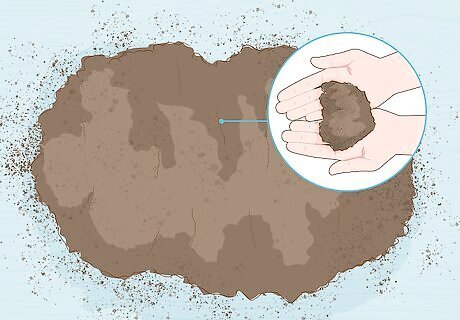
Use a rich, loamy soil to cultivate your clove tree. Clove trees need to be planted in well-draining soil. A rich, loamy, tropical soil creates the best growing conditions for clove. Try soils rich in organic materials like peat moss and compost. Look for a soil mixed with sand, clay, and silt so that it drains well.
Cultivating a Clove Seedling
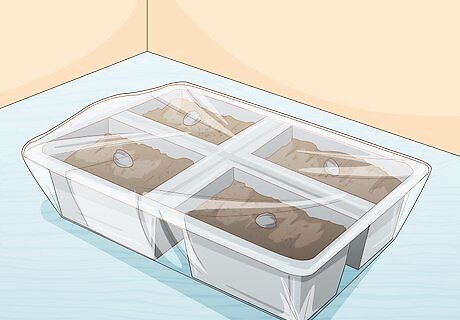
Place a seed on top of well-draining soil and cover it with plastic. Choose a soil that has a high percentage of sand or clay, which will drain. You don't need to plant the seed in the soil yet. Simply place it on top of the soil. To keep humidity levels high while the seed is sprouting, cover the soil with plastic wrap. If you live in a tropical location, you might be able to buy fresh clove seeds from a plant nursery. If you don't, you may to import seeds through an online seller. Don't use dried seeds. Once seeds dry out, they are no longer viable and won't grow at all.

Keep the seedling out of direct sunlight and water it daily. Find a partially-shaded location for your seedling, where your clove plant will receive around 3-6 hours of daily sunlight. Keep the soil damp, but not waterlogged. It might take up to 6 weeks for a seed to germinate. Reduce your watering schedule to every other day if you notice that the soil is still damp after 24 hours.

Transfer a seedling to a 12 inches (30 cm) pot when it is 9 inches (23 cm) tall. Once the plant is 9 inches (23 cm) tall, you can transplant it to a larger pot. Do not move the seedling before it is tall enough. Clove plants are very delicate and might not survive if you transplant them too soon. Let the seedling's soil dry out for 24 hours to make it easier to transfer the plant. The seed might need to grow for up to 6 months before it can be transplanted.

Fill the new pot with well-draining soil and make a hole. Use a soil that is equal parts loam, sand or clay, and organic matter. Fill the pot up to 1 inch (2.5 cm) of the rim with soil. Make a hole big enough to fit the seedling's roots. Dampening the soil slightly can make it easier to make a hole for the seedling to fit in.
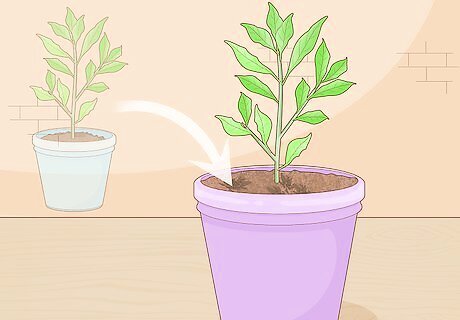
Slide the clove seedling gently out of the old pot and place it in the new pot. Loosen the soil around the seedling and gently pull it out of the soil by the leaves. The stem will be very delicate, so pull as gently as possible. Place the seedling in the new pot. A fork can help you gently loosen the soil around the seedling's roots.
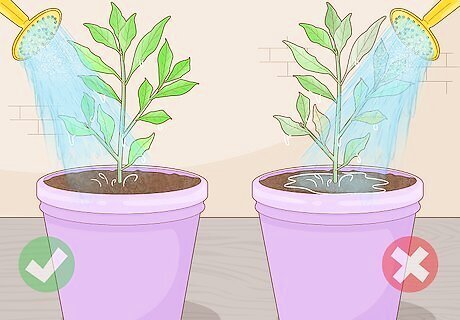
Water the transplanted seedling well. Water the soil until it is damp, but not soaked, all the way through. Wait until the soil dries out to water your seedling again. Overwatering your seedling can kill it. You may need to add a little bit more soil to keep the seedling in place.

Grow the seedling for at least 18-24 months before moving it outside. Clove seedlings mature slowly, but it's important to make sure the seedling is strong enough to survive outside before you transplant it. Once the seedling is 18-24 months, it should be strong enough to transplant. Clove trees can take anywhere from 5-7 years to mature enough to flower. You can also buy mature clove seedlings that can be planted directly outside.
Maintaining a Healthy Clove Tree

Water your clove tree weekly, especially in the first 3-4 years. Young clove trees especially need plenty of water to grow. If you don't live in a rainy place, or if you are growing your clove tree indoors, water it every time the soil dries out, up to once a day. Keep the soil moist, but not waterlogged. To avoid overwatering, keep your tree in a well-draining soil. A clove tree should receive 1 to 1.5 inches (2.5 to 3.8 cm) of water a week.
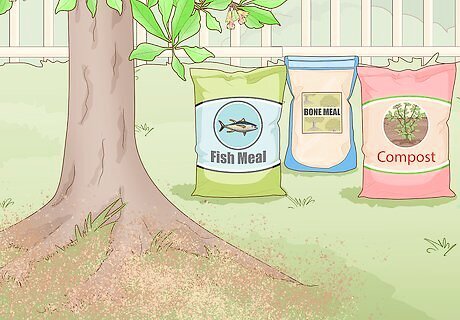
Fertilize your clove tree twice a year. If you live in a place with a rainy season, fertilize your clove tree at the start of the season. Use compost, bone meal, or fish meal to fertilize your tree. If you don't live in a place with a rainy season or you are growing your clove tree inside, fertilize it every 6 months.

Protect your clove tree from common pests and diseases. Prune any branches that die or become diseased to keep the plant healthy. If your tree's flowers are attacked by Oriental Fruit Flies, try covering the flowers with plastic bags to prevent the flies from getting to the plant. Don't use any insecticide or sprays unless you can be sure they are safe for clove trees.
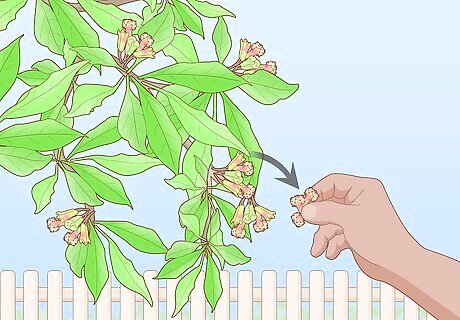
Harvest clove flowers when they turn pink. A healthy clove tree will grow flowers after around 5-7 years. The flowers will grow in white at first, and turn pink after around 6 months. Once the flowers turn pink, they can be harvested. Dry the flowers in an airtight container to use them as spice.

Use cloves to make tea, flavor your cooking, and even clean. To make clove tea, simply boil a few whole cloves in water for 5 minutes. You can also use dried, ground cloves in curries, soups, braised meat dishes, and spiced sweets. Mix clove oil with water to make a homemade air freshener and mold buster. Incorporating cloves in your diet may help regulate blood sugar and increase bone strength.




















Comments
0 comment